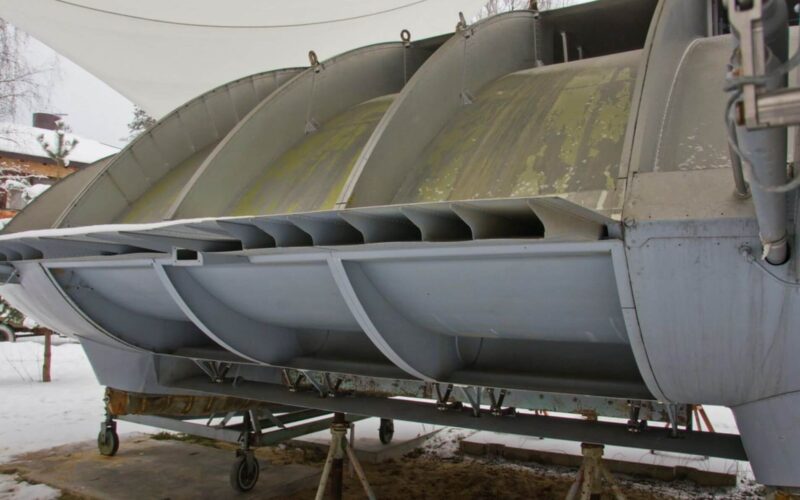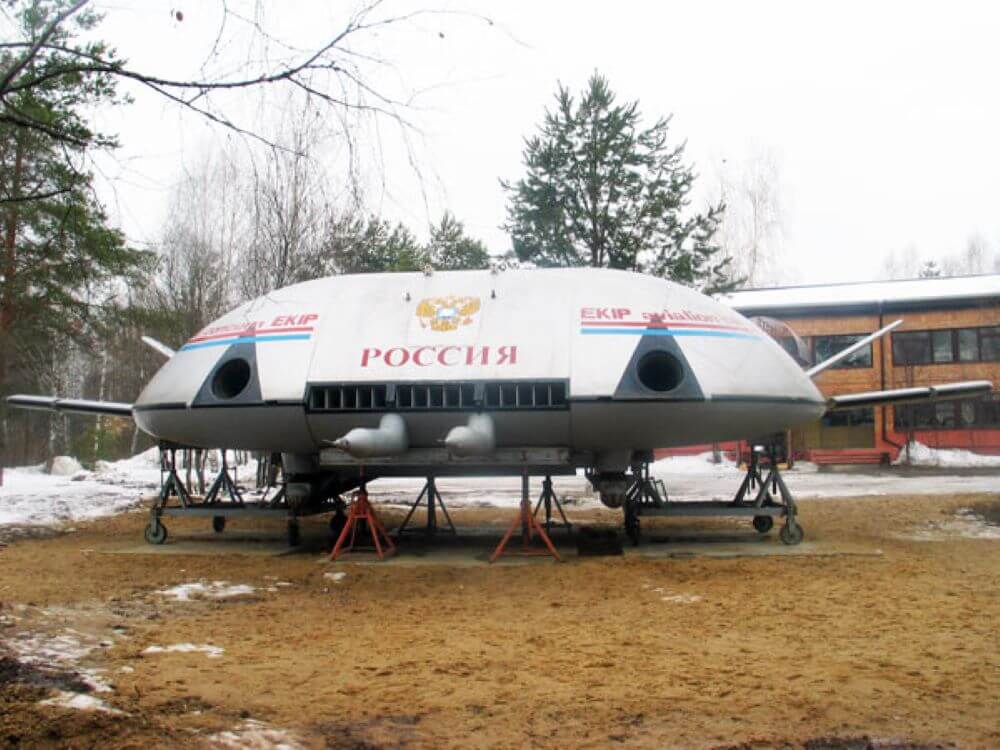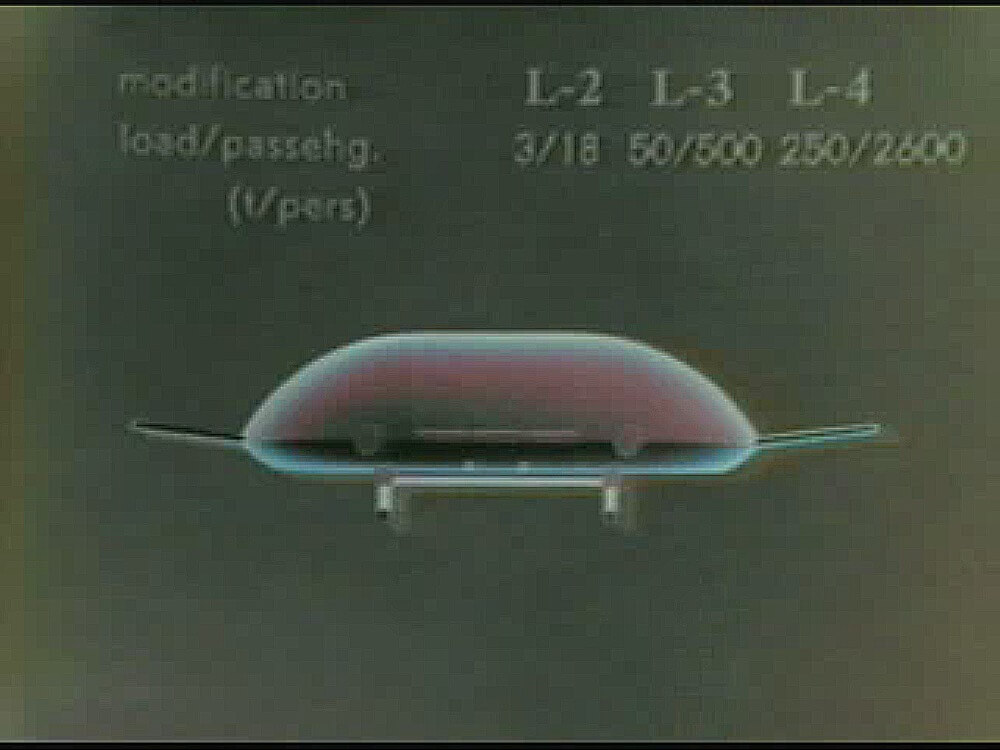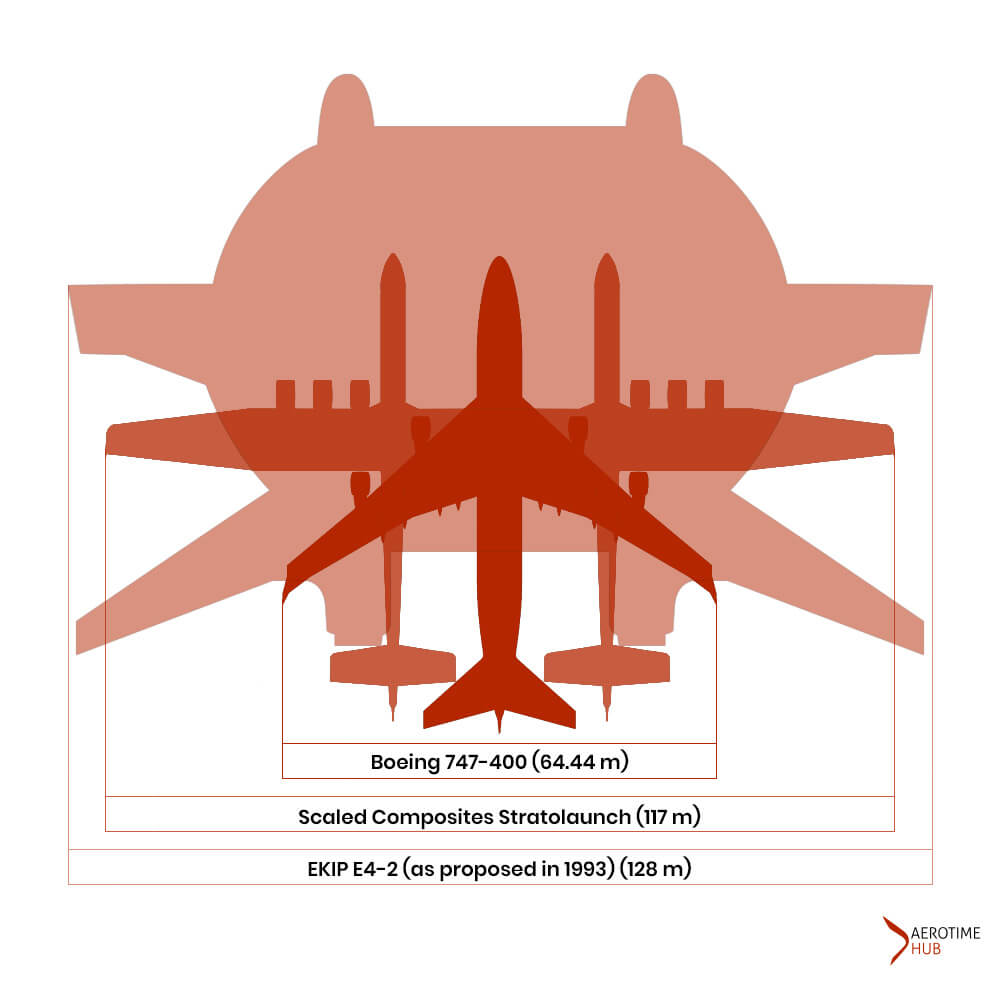EKIP was a project to develop an aircraft with some wondrous properties: a saucer-like flying wing that would be more efficient than any contemporary airplane. After the collapse of the Soviet Union, a company created by its chief engineer – Lev Nikolayevich Schukin – struggled to procure funds to develop the idea. After Schiukin’s death and several unsuccessful attempts to attract Western investors, the company disappeared.
Reportedly, in the late 90s and early 2000s fields and swamps around Saratov became infested with flying saucers. People who went fishing or hiking there got so used to seeing unexplainable phenomena in the sky, nobody even considered such events as unusual.
At the same time, guests of Saratov aviation plant were gladly shown the cause of those legends: incredible inventions of plant’s engineers, suitcase-sized saucer-like vehicles that could take-off vertically, hover above the ground, accelerate and change direction almost instantaneously, and do all of that almost without a sound.
Supposedly, those were models of the EKIP. Nobody saw them performing such feats firsthand, but every journalist reported that somebody – other journalists, plant’s workers, potential investors – could not hide their excitement at what those vehicles can do.
In reality, as opposed to countless sensationalized descriptions in contemporary press, EKIP aircraft were neither able of vertical take-off, nor could hover; they might have been test-flown several times in the mid-to-late 90s, but it is doubtful that tests happened beyond the premises of the factory. So, it is far more likely that Saratov’s UFO legends were inspired by actual extraterrestrial activity, than the EKIP.
Besides local legends, the EKIP team was responsible for half-a-dozen of models of various sizes, as well as several lines of concepts for prospective vehicles based on the idea. Cataloguing all of them is a difficult, but fascinating task.
Material legacy
Of physical artefacts left by the project, the most impressive are the scale models and prototypes that actually got constructed. Most were intended for display or ground tests. At least a couple – L1 and L2 – flew. There was also a prototype of EKIP-AULA L2-3 drone, one of the last products the EKIP aviation concern tried to sell. The drone may or may have not performed some tests, but its main use was to be photoshopped onto impressive vistas, supposedly flying over green forests and clean lakes of Russia.
It was not the one to which the whole name of the project was applied, though. In a lot of material on it, a large metallic aircraft with a wingspan of 14.4 meters and a Russian coat of arms is presented as the crowning achievement of Schiukin. Most people referred to it simply as “the EKIP”, although it had an actual name – the L2-3.
It was intended as a prototype of an actual production variant, representing the smallest of passenger aircraft the concern planned to manufacture. The aircraft was planned to be remotely-controlled though, maybe due to safety concerns, and maybe because the team thought it would be cheaper.
The EKIP L2-3 prototype (Image: EKIP Aviation Concern)
The work on it started in 1993. In several interviews team members claim that two L2-3s are actually under construction, one for ground tests and one capable of flying. Yet later they got combined into one, with parts of the second prototype supposedly manufactured, but never seen on any of promotional photos.
Those parts were produced by Schiukin’s old colleagues from Energia bureau and shipped to Saratov for assembly. The near-finished L2-3 became a backdrop for many videos, photo-ops and articles on the EKIP written in subsequent decades. It was constantly “several months” from being finished, although there are some claims that by 2003 the work on it has actually been complete. It was the same year US Navy got interested in the project, and demonstrating the flight of the large prototype would have been the perfect thing the team could have done to receive funding. Nevertheless, the L2-3 never took off.
It stood in the empty hangar of Saratov aviation plant until its closure in 2011, and then was moved to a museum of village Ivanovskoe, near Moscow. Most likely, it stands there to this day, reminding of the shape that – many hoped – would eventually be seen in the skies above the country.
But actual production models of the EKIP would not have looked like that.
Downsizing the dream
Concepts of EKIP commercial vehicles went through several iterations, fluctuating in size as the project progressed. Names of the models were constantly recycled, a decision that makes understanding the scope of company’s work rather difficult.
The first plan was conceived by 1991 and laid out in team’s promotional video. Saying that it was grand would be an understatement.
Three models were envisioned: the L-2, the L-3 and the L-4, with takeoff weights of 7, 110 and 600 tons, payload capacities of 2, 50 and 250 tons, and passenger capacities of 18, 500 and 2600 respectively. Yes, the largest EKIP was planned to be capable of carrying 2600 passengers.
A snapshot of a promotional video, likely made in 1991. Three models with their cargo and passenger capacities are listed. (Image: EKIP Aviation Concern)
For comparison, An-225 Mriya has a maximum takeoff weight of 640 tons and holds a world record of carrying almost 190 tons of payload Airbus A380, the largest passenger aircraft, usually carries no more than 575 people. It is difficult to say whether Schiukin’s team was taking the idea of building 2600-seat airliner seriously, but before giving this development some thought, let’s briefly discuss what happened later.
By 1993, the team started publishing different numbers: EKIP now had to come in five flavors, from 9-ton L2-3 to 600-ton L4-2. The latter had the same weight as 1991’s L4, but now had 128-meter wingspan (slightly larger than current holder of the World record, the Scaled Composites Stratolaunch) and passenger capacity of 2000. Its cargo capacity dropped to “modest” 200 tons.
As far as it is possible to tell, this set of proposals was kept up until the early 2000s, with some insignificant updates. In either 2000 or 2001 the company presented their competitor to Airbus A3XX (before it got its proper name – A380). The new model was named L3-2DM, and seemingly was a middle ground between earlier L3-2 and L4-1 models, with a passenger capacity of 656.
A couple of years later, most likely in 2002, information on the third set of models was published on one of early iterations of company’s website. The L-4 and its variants were dropped, the L3-2 now was the heaviest one, with the weight of 360 tons and passenger capacity of “only” 1200.
The last outlook of the possible EKIP family remained unchanged for the rest of project’s life. In several subsequent years it was updated with a couple of new proposals, intended to reflect the change of times.
One of them was the EKIP-AULA L2-3, a 350-kilogram model, finished by the company in 2003 and possibly tested on water. The company later described it as a prototype of a reconnaissance and patrol drone, probably intended to be equipped with cameras. Proposal for a heavier drone, simply named EKIP-2, was published a year later, with its passenger variant EKIP-2P capable of carrying 2 people.
So, in a span of several years the team went from proposing airliners the size of a city, to surveillance drones barely able to lift several kilograms of equipment. Meanwhile, almost two decades after project’s death, it is not uncommon to see mentions that the EKIP is going to be a competitor to Boeing 747, Airbus A350, or whatever large aircraft is popular at the time. Sure, those proposals existed, but they were just a fraction of EKIP’s prospective development, and not a well thought-out one at that.
The giants
If built, EKIP L3s and L4s would have been some of the largest aircraft ever constructed. Reportedly, some of them were supposed to have three decks, but most likely the team never went as far as modelling the aircraft beyond the basic shape.
Several scale models of 1993-version of EKIP L3-1, with 80 red seats in a semi-transparent plastic fuselage, offer the only glimpse into how this type of vehicle could have looked. If Schukin or his colleagues ever made blueprints of other models, they are, most likely, lost.
Scale model of 1993 variant of EKIP L3-1 (Image: EKIP Aviation Concern)
It is not difficult to see some logic in their designs though, with clear divisions between regional, mid-sized and intercontinental jets. It seems, dreaming big was team’s specialty, as every time after coming up with a new set of models, they could not help but include some ridiculously-sized ones.
The ones with the capacity of over 1000 passengers nowadays look nothing but absurd, but we have to remember that those were the early 90s. Airbus A380 has just entered development, and superjumbos seemed like the next big step in civilian aviation. In ex-Soviet countries alone, every major engineering bureau had plans to develop one, from the innovative Sukhoi KR-860 to the 1200-seat Tupolev Tu-404. The EKIP L4 and L4-2 would have overshadowed all of them though.
How realistic were these proposals? If we discard the most ridiculous claims made by journalists and other enthusiasts, and look at numbers presented by the EKIP team at the very end of its existence, some of the data starts looking quite possible. The L3-1, as described in 2002, would supposedly be able to fly 4,000 kilometers on 14 tons of fuel while carrying 160 passengers. Similarly sized Embraer E195-E2 regional jet, while carrying up to 146 passengers, has a range of 4,900 kilometers and carries 13.7 tons of fuel. L3-1’s payload capacity and weight are also somewhat similar to the E195-E2.
Just for the fun of it, here is a comparison of the largest EKIP proposal (E4-2 from 1993) with some real aircraft. (Image: AeroTime News)
On the other hand, with their heaviest models, EKIP team strayed straight into fantasy. In most cases they seemed to calculate the payload capacity of an aircraft and divide it by roughly 100 kilograms to get the passenger capacity. With smaller planes such a calculation is somewhat close to reality. With larger ones it does not work.
Boeing 747-400 has a passenger capacity of 416, while 747-400F freighter’s maximum payload capacity is less than 125 tons. Airbus A380 can carry between 575 and 853 passengers depending on the configuration, and its freighter version, while never built, was intended to carry no more than 150 tons.
If the formula EKIP’s engineers applied to their aircraft worked, 747-400 and A380 would be able to carry 1250 and 1500 passengers respectively, but that is not the case. Mainly because passenger cabins require seating, heating, toilets, entertainment systems and other amenities without which people would not agree to enter the aircraft.
The weight adds up, especially on long-haul aircraft. The fact that Schukin’s team did not consider those requirements shows that they did not reach the phase of actually designing most of their proposed aircraft, and presented numbers based purely on calculations. And even with those, the wondrous properties of their aircraft were somewhat on par with early-21st century jets.
But to have those properties – with the bulky fuselage, heavy air cushion system and other features not present on sleek modern jets – the main requirement had to be met. The incredible increase in efficiency, provided by the boundary layer control system.
Its properties are yet another mystery we have to unravel. In fact, Schukin and his colleagues were not the first, and not the last ones to research this concept – some aviation enthusiasts attempted to implement in several decades earlier, and in 2005, after the EKIP aviation concern practically ceased its existence, some European scientists began quite a monumental project to study the phenomenon.





